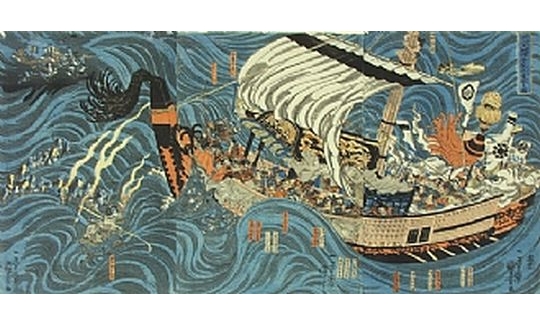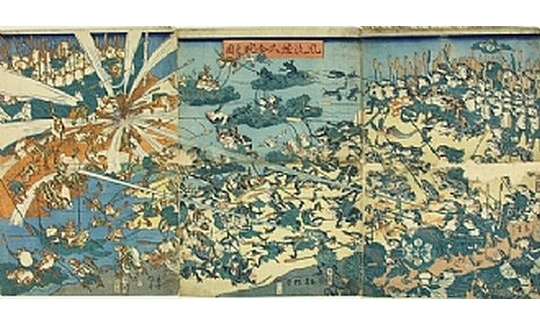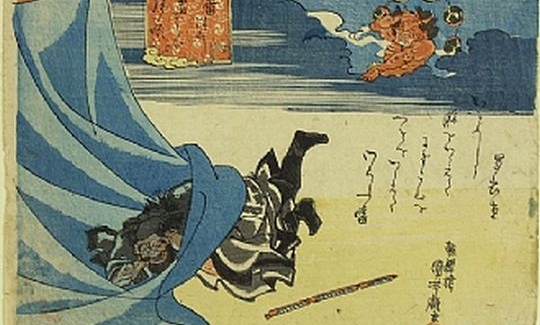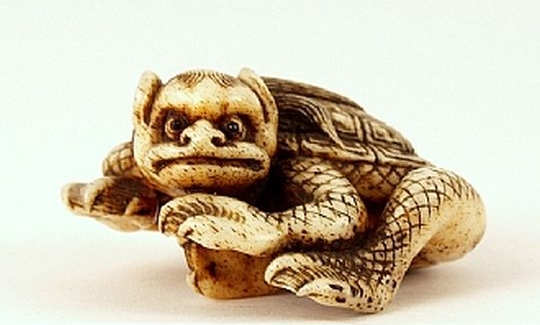Belief in demons and spirits has been deep-rooted in Japanese folklore throughout history. It is entwined with mythology and superstitions derived from Japanese Shinto, and Buddhism and Taoism brought to Japan from India and China.
Every culture has its own fashion of regarding the universe and trying to explain it. Inexplicable phenomena arouse fear in mankind, because there is no way of anticipating them. For this reason attempts are often made to explain them as supernatural forces. Fables and legends about demons and spirits are another vital aspect of awareness and understanding of the cultures of the Far East in general, including Japan, enchanting children and adults alike. Artists and poets worldwide find in them an inexhaustible source of inspiration for their creations.
The Japanese believe that they are surrounded by spirits at all times. In the Shinto faith, the original Japanese religion, it is believed that eight million deities inhabit the heavens and the earth - the mountains, the rivers, the trees and stones, houses and storerooms, even the cooking stove and the toilet. Traditional Japanese homes made of wood often creak, due to the method of construction. These groans and sighs have always been suggestive to the imagination. Professor Inoue Enryo of Kyoto University was known as the "professor of demons and ghosts" (Bakemono Hakase) because he investigated such sounds and catalogued them as different types of demons and ghosts. Inoue wrote a number of books on the subject, among them "The Original Treatise on Demons and Ghosts" (Bakemono no Shotai).
According to Shinto belief, after death man becomes a spirit, sometimes even a deity. Buddhism, which made its way through the open gates of Japan in the 6th century CE, brought with it a belief in supernatural forces - the spirits of the dead, and other creatures with supernatural powers. The many Shinto deities are also a basis for the invention of demons. A fable tells of Susanoo no Mikato, brother of the goddess of the sun, whose heart swelled as a result of a fit of anger, until finally Ama no Zakogami, goddess of the tengu, burst out of it - the tengu being mythological deities, forest-dwellers with supernatural powers.
During the Heian dynasty (794-1185), many believed in the supernatural, in the presence of spirits of the dead floating among the living, demons causing disease, plagues, hunger and other evils. These demons appeared as fire, or lightning, or were heard as thunder. In the Kamakura era (1185-1333) belief was reinforced in the ghosts of the dead and the power of different creatures, such as foxes, Japanese raccoons, and snakes, to lead man astray. According to this belief, such creatures were able to transform themselves into different beings. This became evident when they lived longer than usual, or behaved in an abnormal fashion. In the Muromachi period (1336-1573) it was believed that even objects could be demons. Household goods, when they are a hundred years old, also become deities (Tsugumo no Kami; ninety-nine-year deities). In Japanese folklore there are tales of objects inhabited by deities, so that they must be treated with special care and respect. Natural or man-made objects can possess special powers if they have existed for a long time. Each year the Japanese cleanse their homes (Susuharai) because they believe that if they do not, these articles will be contaminated, which would create negative phenomena.
In the Momoyama (1573-1600) and Edo (1603-1868) periods, they believed that even if a man was virtuous in his lifetime, he could be transformed into a demon or a monster after his death, particularly if he died as a result of disease or epidemic. In the case of unnatural death a man might even become a beast, perhaps a dog or a snake. It was also believed that animals had the power to change into spirits or demons, and this subject was depicted in art more frequently than in the past.
Even today, tales of ghosts and demons are still presented on the television and in the newspapers. Fables and folk-tales sustain these beliefs, and they are expressed in all aspects of Japanese art: in drawings, paintings, prints, sculpture, and theatre. These subjects are often artistically depicted in their historical or socio-cultural contexts, and must also be comprehended from these aspects.
The Japanese assume that their natural surroundings are filled with spirits with supernatural powers which can be found in everything. These deities have the power to help mankind to overcome evil forces, and to change bad luck to good.
In the Kojiki (Register of Antiquities, 712 CE), the universe is divided into three levels - Takama-ga-hara - the upper heavens, where the gods dwell, Naka-tsu-kuni - the middle world, home of the deities of the earth, and Yomi-no-kuni - the land of the dead, inhabited by the souls of the dead, virtuous and wicked alike.
The Land of the Dead was not a place of punishment or re-education, even though it is often connected with impurity. When Buddhism reached Japan, belief in the world of the living, the world of the dead, and the land of the pure Buddha (Jodo: The Pure Land in the Far West) achieved a new meaning. The world of the dead became a kind of hell. The way a man conducted himself during his lifetime decided whether he would go to hell or to the Pure Land after his death.
At the close of the Heian era, Genshin (942-1017), a monk of the Tendai cult, began to use, in his sermons, paintings intended to persuade believers to pray to the goddess of mercy in order to achieve enlightenment. These paintings, known as Jigoku-e (Paintings of Hell), are examples where demons are depicted as the emissaries of Emma Daio, the ruler of hell.
With time, the folk arts of Japan became so integrated with Buddhist belief that it is often difficult to differentiate between them. The Japanese believe that after death a man's soul is angry and impure (aramitama). For this reason rituals are performed for seven years to pacify and purify the soul (25 days after death; on the anniversary; in the 7th year, etc.). In this way the person becomes a spirit watching over his family and their prosperity, and protecting his descendants (sorei). According to belief, spirits which have not yet reached this stage have not travelled far enough from their houses to reach the Land of the Dead, and wander between the land of the living and the world of shadows. For this reason, the family is careful to pray for the peace of his soul, and to offer him tributes. If they do not, the spirit will remain close the house for far longer than necessary, and will persecute the family and cause disasters. Spirits of the dead which have not undergone purification rituals can easily return to the land of the living as demons.
Even personal emotions can become demonic beings. If the dead person is not dissociated from such sensations as anger, jealousy or vain desires, his spirit will return to earth as a demon and persecute those responsible for his bitter fate. Sometimes the soul returns as a ghost, to haunt the place where it had spent its life.
To all this was added belief in esoteric ceremonies. The Japanese who have learned the Chinese Tao traditions believe that man can achieve eternal life by means of intensive physical and spiritual exercises. This is expressed in the Shugendo sect, which arose in the Heian era. This sect sees the mountains as the dwelling place of the gods and the Buddhas, and this belief has developed into a form of mountain worship. Many mountain peaks in Japan are considered sacred (Reizan) and they are greatly revered.
Demons appear at dusk. In the Heian era it was believed that on particular nights, the demons and ghosts march in procession and vanish at dawn. In the 14th century a decorated scroll depicting this subject with humour and without any religious bias was made. This is the Hyakki Yakko, or Hyakki Yagyo - the night procession of one hundred demons. (The expression "one hundred" implies a large number.) It shows demons and other strange creatures marching, usually from right to left, until daybreak. In 1776 Toriyama Sekien (1713-1788) published a book called "The Night Procession of the One Hundred Demons", which contains more than one hundred and fifty demons, spirits, and ghosts. The procession of demons was the basis of the popular game called "The Hundred Tales" (Hyaku Monogatari) which was played in the Edo era. After sunset a number of people gathered together, lit 100 candles, and began to tell stories about demons and ghosts. At the end of each story, one candle was extinguished, until they finally sat in complete darkness. In the dark there was a sense that something really frightening was occurring. Originally it was the samurai who played this game in order to test their courage, and it later became a popular pastime among the merchants in the big cities. At the same time books began to appear on the subject. The Bunka (1804-1818) and Bunsei (1818-1829) periods were the golden era of the demon and ghost stories. Hayashiya Shozo (1781-1842), a professional storyteller in the popular folk theatre (Yose), created a new genre of ghost stories in Edo (Kaidan Banshi). His repertoire also included the "One Hundred Tales". From the beginning of the 19th century this collection was also the subject matter of ukiyo-e prints (pictures from the Floating World). One of the most famous tales was that of Kohada Koheiji. Koheiji was murdered by a theatrical personage named Adachi Sakuro, who had an affair with Otsuka, Koheiji's second wife. Sakuro and Otsuka married after Koheiji's murder, but his ghost haunted them, and they ultimately came to an unnatural and untimely end. A Kabuki play on this theme was the source of several well-known scenes presented in woodblock prints. One of these was a representation of the ghost of Koheiji approaching the mosquito net covering his wife's bed. The ghost is shown leaning over the net, and the flames which form his body are symbolic of his great anger and desire for revenge. Sometimes the story, or the relevant section of it, is inscribed at the top of such pictures.




